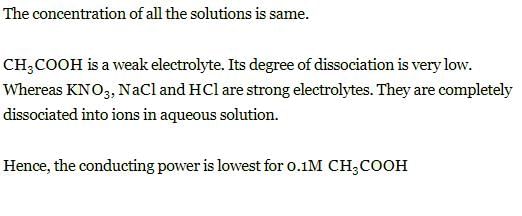Chemistry Exam > Chemistry Questions > Which one of the following solutions has lowe...
Start Learning for Free
Which one of the following solutions has lowest conducting power:
- a)0.1 M CH3COOH
- b)0.1 M NaCl
- c)0.1 M KNO3
- d)0.1 M HCl
Correct answer is option 'A'. Can you explain this answer?
Verified Answer
Which one of the following solutions has lowest conducting power:a)0.1...

Most Upvoted Answer
Which one of the following solutions has lowest conducting power:a)0.1...
**Answer:**
To determine the solution with the lowest conducting power, we need to consider the dissociation of the solutes in water. The greater the degree of dissociation, the higher the conducting power of the solution.
**Dissociation of the solutes:**
a) CH3COOH (acetic acid):
CH3COOH ⇌ CH3COO- + H+
b) NaCl (sodium chloride):
NaCl ⇌ Na+ + Cl-
c) KNO3 (potassium nitrate):
KNO3 ⇌ K+ + NO3-
d) HCl (hydrochloric acid):
HCl ⇌ H+ + Cl-
**Factors affecting the degree of dissociation:**
1. Nature of the solute: Strong acids and strong bases dissociate completely in water, while weak acids and weak bases dissociate to a lesser extent.
2. Concentration of the solution: Higher concentrations tend to increase the degree of dissociation.
**Explanation:**
a) 0.1 M CH3COOH (acetic acid):
Acetic acid is a weak acid and does not dissociate completely in water. It only partially ionizes into CH3COO- and H+. Therefore, the conducting power of this solution will be lower compared to the others.
b) 0.1 M NaCl (sodium chloride):
Sodium chloride is an ionic compound and dissociates completely into Na+ and Cl- ions in water. This solution will have a higher conducting power compared to acetic acid.
c) 0.1 M KNO3 (potassium nitrate):
Potassium nitrate is also an ionic compound and dissociates completely into K+ and NO3- ions in water. This solution will have a higher conducting power compared to acetic acid.
d) 0.1 M HCl (hydrochloric acid):
Hydrochloric acid is a strong acid and dissociates completely into H+ and Cl- ions in water. This solution will have a higher conducting power compared to acetic acid.
Therefore, the solution with the lowest conducting power is 0.1 M CH3COOH (acetic acid) due to its weak acid nature and partial dissociation in water.
To determine the solution with the lowest conducting power, we need to consider the dissociation of the solutes in water. The greater the degree of dissociation, the higher the conducting power of the solution.
**Dissociation of the solutes:**
a) CH3COOH (acetic acid):
CH3COOH ⇌ CH3COO- + H+
b) NaCl (sodium chloride):
NaCl ⇌ Na+ + Cl-
c) KNO3 (potassium nitrate):
KNO3 ⇌ K+ + NO3-
d) HCl (hydrochloric acid):
HCl ⇌ H+ + Cl-
**Factors affecting the degree of dissociation:**
1. Nature of the solute: Strong acids and strong bases dissociate completely in water, while weak acids and weak bases dissociate to a lesser extent.
2. Concentration of the solution: Higher concentrations tend to increase the degree of dissociation.
**Explanation:**
a) 0.1 M CH3COOH (acetic acid):
Acetic acid is a weak acid and does not dissociate completely in water. It only partially ionizes into CH3COO- and H+. Therefore, the conducting power of this solution will be lower compared to the others.
b) 0.1 M NaCl (sodium chloride):
Sodium chloride is an ionic compound and dissociates completely into Na+ and Cl- ions in water. This solution will have a higher conducting power compared to acetic acid.
c) 0.1 M KNO3 (potassium nitrate):
Potassium nitrate is also an ionic compound and dissociates completely into K+ and NO3- ions in water. This solution will have a higher conducting power compared to acetic acid.
d) 0.1 M HCl (hydrochloric acid):
Hydrochloric acid is a strong acid and dissociates completely into H+ and Cl- ions in water. This solution will have a higher conducting power compared to acetic acid.
Therefore, the solution with the lowest conducting power is 0.1 M CH3COOH (acetic acid) due to its weak acid nature and partial dissociation in water.
Free Test
FREE
| Start Free Test |
Community Answer
Which one of the following solutions has lowest conducting power:a)0.1...
It is a weak electrolyte

|
Explore Courses for Chemistry exam
|

|
Question Description
Which one of the following solutions has lowest conducting power:a)0.1 M CH3COOHb)0.1 M NaClc)0.1 M KNO3d)0.1 M HClCorrect answer is option 'A'. Can you explain this answer? for Chemistry 2025 is part of Chemistry preparation. The Question and answers have been prepared according to the Chemistry exam syllabus. Information about Which one of the following solutions has lowest conducting power:a)0.1 M CH3COOHb)0.1 M NaClc)0.1 M KNO3d)0.1 M HClCorrect answer is option 'A'. Can you explain this answer? covers all topics & solutions for Chemistry 2025 Exam. Find important definitions, questions, meanings, examples, exercises and tests below for Which one of the following solutions has lowest conducting power:a)0.1 M CH3COOHb)0.1 M NaClc)0.1 M KNO3d)0.1 M HClCorrect answer is option 'A'. Can you explain this answer?.
Which one of the following solutions has lowest conducting power:a)0.1 M CH3COOHb)0.1 M NaClc)0.1 M KNO3d)0.1 M HClCorrect answer is option 'A'. Can you explain this answer? for Chemistry 2025 is part of Chemistry preparation. The Question and answers have been prepared according to the Chemistry exam syllabus. Information about Which one of the following solutions has lowest conducting power:a)0.1 M CH3COOHb)0.1 M NaClc)0.1 M KNO3d)0.1 M HClCorrect answer is option 'A'. Can you explain this answer? covers all topics & solutions for Chemistry 2025 Exam. Find important definitions, questions, meanings, examples, exercises and tests below for Which one of the following solutions has lowest conducting power:a)0.1 M CH3COOHb)0.1 M NaClc)0.1 M KNO3d)0.1 M HClCorrect answer is option 'A'. Can you explain this answer?.
Solutions for Which one of the following solutions has lowest conducting power:a)0.1 M CH3COOHb)0.1 M NaClc)0.1 M KNO3d)0.1 M HClCorrect answer is option 'A'. Can you explain this answer? in English & in Hindi are available as part of our courses for Chemistry.
Download more important topics, notes, lectures and mock test series for Chemistry Exam by signing up for free.
Here you can find the meaning of Which one of the following solutions has lowest conducting power:a)0.1 M CH3COOHb)0.1 M NaClc)0.1 M KNO3d)0.1 M HClCorrect answer is option 'A'. Can you explain this answer? defined & explained in the simplest way possible. Besides giving the explanation of
Which one of the following solutions has lowest conducting power:a)0.1 M CH3COOHb)0.1 M NaClc)0.1 M KNO3d)0.1 M HClCorrect answer is option 'A'. Can you explain this answer?, a detailed solution for Which one of the following solutions has lowest conducting power:a)0.1 M CH3COOHb)0.1 M NaClc)0.1 M KNO3d)0.1 M HClCorrect answer is option 'A'. Can you explain this answer? has been provided alongside types of Which one of the following solutions has lowest conducting power:a)0.1 M CH3COOHb)0.1 M NaClc)0.1 M KNO3d)0.1 M HClCorrect answer is option 'A'. Can you explain this answer? theory, EduRev gives you an
ample number of questions to practice Which one of the following solutions has lowest conducting power:a)0.1 M CH3COOHb)0.1 M NaClc)0.1 M KNO3d)0.1 M HClCorrect answer is option 'A'. Can you explain this answer? tests, examples and also practice Chemistry tests.

|
Explore Courses for Chemistry exam
|

|
Signup for Free!
Signup to see your scores go up within 7 days! Learn & Practice with 1000+ FREE Notes, Videos & Tests.


















